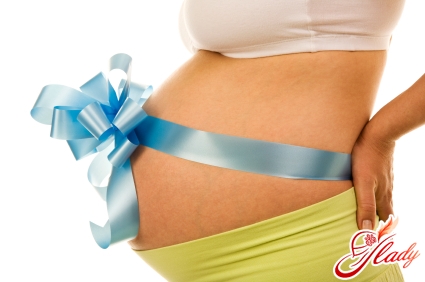 It is difficult to recommend an absolutely ideal pose forchildbirth, but the ideal means to ensure comfortable delivery is - it's movement. The most incorrect attitude to the movement during childbirth is the stereotyped idea that a woman in bed should lie on her back. Women are so fixated on this pose that they are forced to suppress the instinctive desire to rise during the fights. Use your instincts to take the right pose before the fight or during it and thus ease the pain. Movement is one of the main components of successful delivery. A modern woman needs to be reprogrammed and returned to long-forgotten instincts. Women, brought up in the traditions of culture of different countries and peoples, not providing a horizontal position during childbirth, mainly accept vertical or inclined poses.
It is difficult to recommend an absolutely ideal pose forchildbirth, but the ideal means to ensure comfortable delivery is - it's movement. The most incorrect attitude to the movement during childbirth is the stereotyped idea that a woman in bed should lie on her back. Women are so fixated on this pose that they are forced to suppress the instinctive desire to rise during the fights. Use your instincts to take the right pose before the fight or during it and thus ease the pain. Movement is one of the main components of successful delivery. A modern woman needs to be reprogrammed and returned to long-forgotten instincts. Women, brought up in the traditions of culture of different countries and peoples, not providing a horizontal position during childbirth, mainly accept vertical or inclined poses.
Why is vertical labor better than horizontal?
First of all, let us answer the question why the posture of lyingon the back is uncomfortable for the mother and not entirely safe for the child. First of all, it is the law of gravity: when the mother is lying on her back, gravity pulls the child to the back. This abnormal posture leads to two abnormal things: causing pain in the back of the mother and because of the pressure on the blood vessels running along the spine, reduces the flow of blood to the uterus. Pathological phenomena begin to grow like a snowball. The mother may lose pressure, the child may receive insufficient oxygen, the uterus is reduced less efficiently, the birth is hampered, the mother is forced to push the child "uphill." If the mother's legs are raised, she has to dissect the perineum. As a result, both mother and child suffer. Consider what happens when a mother sits, stands or is supported by a partner. Gravity pulls the child down, as the mother's posture is in harmony with the forces of nature. The child is easier to go through the birth canal, and the cervix is opened faster. The child passes the pelvis at the right angle and meets the least resistance in the birth canal. When the mother does not experience additional pressure on her back, she feels less pain. Contractions are more effective, labor is faster. The connective tissues of the pelvis are weakened by the hormones of pregnancy, they become more mobile. When you are in a vertical position, the birth canals become wider, they are easier to adapt to letting out a small man with a large head and broad shoulders. If you are lying or sitting, the bones can not move freely and the birth canal narrows. In addition, the vertical posture is more gentle for the perineum. In this case, the need for episiotomy disappears, and ruptures are unlikely. Modern researchers have given a lot of evidence of the advantages of vertical poses for childbirth. When a woman moves during childbirth and gives birth in a vertical posture, she experiences less pain, she is less likely to require anesthesia. In addition, the time of childbirth is reduced, episiotomy is less likely, the likelihood of ruptures is small, electromonitoring of the fetus shows a more satisfactory state of the child whose body is better supplied with blood and oxygen. Childbirth in vertical poses has long been included in the practice of the midwives, but still unfamiliar to most midwives. In the textbooks on obstetrics there is no picture of a mother squatting down, a partner supporting her from behind, and an obstetrician kneeling and taking the baby from below. Do not think that if the doctor kneels, it will detract from his professionalism. The best posture for delivery is the one in which you are comfortable. Choose a place for delivery where you will be free in your choice, and an obstetrician who will support your choice. There is no posture in which the mother will be able to stay during all births. Below we describe some of the most convenient poses. Squatting is the best posture for childbirth. It fits both mother and child for the following reasons:
- accelerates the process of childbirth;
- expands the pelvis;
- relaxes the muscles of the perineum;
- relieves pain in the back;
- improves the supply of oxygen to the child;
- promotes an easier birth of the afterbirth.
Even with a small capacity of the pelvis and large fruitThe probability of vaginal birth in this position is significantly increased. When you sit on all fours, the angle of the pelvis is most convenient for moving the child through the birth canal, and gravity helps him in this. If you give birth lying on your back, the child has to get out of the narrow and curved passage. Change the pose, and before it opens a more direct and wide path. This position is most suitable for accelerating childbirth. Contractions become more intense, as the head of the child presses on the cervix. If during a squatting squabble becomes too painful, but the birth is normal, try to take a more comfortable position for you. Squatting almost does not need to sit during the first stage of labor, when the cervix begins to open. Do not tire your feet and waste energy. They will be useful to you during attempts. It is best to squat when the delivery provider says that the cervix is fully open and approaching or the second stage of labor begins. The urge to push is a signal for you to squat. When the fight begins, tighten up, and then sit back or forward, on your knees, to rest before the next fight. In this position, the second stage of labor proceeds more quickly, but it can be more intense. It is unlikely that you will be offered a variant of pedigree delivery in the district maternity hospital. This pose must be learned during pregnancy, and you must help your partner or assistant. Your partner must learn to support the mother in advance so that you can trust yourself and each other. A partner is better to be barefoot. Stand up behind the woman in childbirth and place your feet shoulder width apart. Take the woman in bed under her armpits and let her hang in your arms. Keep your back straight, bend your legs slightly at the knees so that the woman in labor can lean on them with buttocks. You can lean your back on the wall or sit behind the woman in bed. Keep her until she kneels or sits back. The more you train, the easier it will be for you to squat during the delivery. Put your feet to the width of your shoulders and slowly (not jerkily!) Drop down. Spread the knees on the width of the feet, then rest on the floor with your heels. If it is difficult for you to press the entire foot to the floor, put on your shoes on a small heel. In order not to forget that the knees need to be bent to the sides, bend your hands and rest your elbows on the inside of your knees. Squatting can be quite a tedious task. So try the following options for this pose:
Squatting with the support of
Supporting you, your partner stands behind you, leaning back against the wall, the back of the bed or sitting on a chair. Or he can sit in front of you and hold your hands so that you are in balance.
Squatting with the support of
In this posture, the most effectivethe use of gravity, and the angle of the pelvis is optimal for delivery. Putting your feet to the width of your shoulders, you hang in the arms of a partner. In this position, not only the body relaxes, but also the mind. The best way to achieve satisfactory births is to obey your body. Relax your stomach like you are on the eleventh month. Let him sag more with every fight. If you try to pick up a stomach and strain the muscles, it can hurt you. In addition, you can lean against a wall, sit on a chair, hold on to the edge of the table, the back of a chair or a bed. Do not try to jump on all fours, as this greatly stretches the muscles and ligaments. Some women accelerate childbirth and reduce pain, swinging from side to side. Do not overexert yourself. Use to support your body cushions, furniture, walls, people - everything that will help you reduce the tension of the legs, relax the uterus and completely switch your attention to childbirth. The receiving genera are more tolerant of the genera lying on their side or half-sitting, since in these poses they can see what is happening. But those who receive birth can have access to the mother and child in any posture. The natural transition from the squat position is the position on the knees. When the fights become too strong, you can rest on your knees on the pillow on the floor, leaning on a chair or standing on all fours. Standing on all fours is especially useful for back pain, when you try to turn the child walking by the buttocks, or to slow the too rough births a little. If you do not want to slow down the birth, take such a position that the stomach is placed as vertically as possible, and the knees are parted to expand the pelvis. And do not forget to put cushions under your feet and head. Kneeling, many women have a natural need to shake their hips from side to side. This helps the child to turn over from the buttocks to the head. If you feel the need to change your posture, do not deny yourself this. If you use a bed for childbirth, then kneel on the dropping part and lean on the top. Squatting, lower one leg to the knee. Periodically change your legs and try to swing from side to side in between breaks.
Knee-elbow position
A very valuable kind of pose on the kneesis knee-elbow. You can also take the so-called "embryo pose", that is, lower your head below the pelvis. In this position, the head of the child stops pressing on the cervix, which softens the contractions and weakens the desire to push, if it is necessary (for example, when the cervix can not fully open). In this position, too rapid birth can be slowed down. During the first stage of labor, it may be more convenient for you to walk a lot and stop only during labor. Instead of just standing, transfer some of the weight of your body to the pedestal. To do this, lean against a wall, chair or other piece of furniture. You can also lean on a partner, while putting one leg on a chair. At this moment, the man will especially feel how you need him.
Posture sitting
If in the squatting position the bouts seemyou are too strong, you probably can handle them sitting. Sit on a low chair, toilet, chair or corner of the bed for delivery. It is best to sit with your legs spread wide on a low chair. If a woman sits during the second stage of childbirth, it passes faster than if it lies. In this position, the pelvis becomes wider (but not as much as in the squatting position), the bleeding during childbirth is noticeably reduced, and the supply of oxygen to the baby is improved. By the way, the toilet seat is a natural throne for childbirth, which is always at hand. Its height is ideal for delivery, and the pelvis and legs have long been used to it. And, finally, it can be the only place in the whole world where a woman in childbirth can retire. The toilet not only serves as a refuge, but it is also very important from the point of view of the midwife. Mothers often go to this familiar place to resume childbirth. When the mother is sitting on the toilet, the bouts become stronger. The tension of the abdominal muscles and the movement of the pelvic bones during defecation are similar to the second stage of labor. In this comfortable pose, the bladder empties more readily, giving more room to the baby. In this position (knees are divorced, the muscles of the pelvis are relaxed) it is most convenient to give birth. To reduce the strength of the battles, lean on the table near the seat. Needless to say, medical personnel are scared to death that if a toilet is used during labor, it can be used for delivery. To carry out attempts, the mother, sitting in the toilet, waits for the cutting of the head, and then stands up to give birth to the child, which is picked up by the receiving child. If the childbirth lasts a long time, you will not be able to stand all the time. Many women easily endure contractions, lying on their sides. Theoretically, it is better to lie on the left side, so that the uterus does not press on the blood vessels passing from the right side of the spine. While lying on its side, you are deprived of the help of gravity, the uterus does not press on the back. In this position it is convenient to rest between fights and you can slow down too rough births. Make yourself a comfortable nest of pillows, with one or two pillows under your head and one under your stomach, upper leg and back. During the bout, you can lie down if you need to slow birth, or quickly roll to your knees and take a vertical pose. If you decide to push, lying on your side, the delivery partner or partner can lift your upper leg to increase the capacity of the pelvis. If possible, try to think out your postures and movements that will help you. During labor, use any postures so long as they work. Freedom of movement during childbirth and vertical poses are proven experiences in ways to get the most satisfactory birth. In conclusion, this chapter will repeat once again the advice that allows you to create progress in childbirth:
- If you are forced to stay in bed for medical reasons, often change your posture.
- For relaxation of muscles and consciousness, use massage, imagination, breathing exercises, music, etc.
- Every hour, release the bladder; A full bladder causes painful spasms.
- Use the help of gravity: go, stand on your knees, squat, sit.
- Between the contractions rest and get rid of the tension of the previous bout. Do not allow yourself to experience fear in anticipation of the next fight.
- Raise your energy level: snack if you get hungry; Drink to avoid dehydration.
- If childbirth becomes difficult to bear, immerse yourself in a bath or take a shower.
- Use the constant support of your partner and professional assistant.
We advise you to read:









